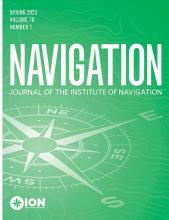Research ArticleOriginal Article
Open Access
Euclidean Distance Matrix-Based Rapid Fault Detection and Exclusion
Derek Knowles and Grace Gao
NAVIGATION: Journal of the Institute of Navigation March 2023, 70 (1) navi.555; DOI: https://doi.org/10.33012/navi.555
Derek Knowles
1Department of Mechanical Engineering, Stanford University
Grace Gao
2Department of Aeronautics and Astronautics, Stanford University

REFERENCES
- ↵
- Ahn, H. -S., &
- Oh, K. -K.
- ↵
- Bilich, A., &
- Larson, K. M.
- ↵
- Blanch, J.,
- Walter, T., &
- Enge, P.
- ↵
- Borowski, H.,
- Isoz, O.,
- Eklöf, F.,
- Lo, S., &
- Akos, D.
- ↵
- Dattorro, J.
- ↵
- Destino, G.,
- Macagnano, D., &
- Abreu, G.
- ↵
- Dokmanic, I.
- ↵
- Dokmanic, I.,
- Parhizkar, R.,
- Ranieri, J., &
- Vetterli, M.
- ↵
- Drineas, P.,
- Javed, A.,
- Magdon-Ismail, M.,
- Pandurangan, G.,
- Virrankoski, R., &
- Savvides, A.
- ↵
- Enge, P. K.
- ↵
- Fu, G.,
- Khider, M., &
- van Diggelen, F.
- ↵
- Holm, L., &
- Sander, C.
- ↵
- Horn, R. A., &
- Johnson, C. R.
- ↵
- Joerger, M.,
- Chan, F. -C., &
- Pervan, B.
- ↵
- Kalman, R. E.
- ↵
- Knight, N. L.,
- Wang, J., &
- Rizos, C.
- ↵
- ↵
- Knowles, D., &
- Gao, G.
- ↵
- Ma, X.,
- Yu, K.,
- Montillet, J. -P., &
- He, X.
- ↵
- Oguz-Ekim, P.,
- Gomes, J. P.,
- Xavier, J., &
- Oliveira, P.
- ↵
- Parkinson, B. W., &
- Axelrad, P.
- ↵
- Pullen, S., &
- Joerger, M.
- ↵
- Reisdorf, P.,
- Pfeifer, T.,
- Breßler, J.,
- Bauer, S.,
- Weissig, P.,
- Lange, S.,
- Wanielik, G., &
- Protzel, P.
- ↵
- Tenenbaum, J. B.,
- De Silva, V., &
- Langford, J. C.
- ↵
- Wang, L.,
- Groves, P. D., &
- Ziebart, M. K.
- ↵
- Wu, Z.,
- Yao, Z., &
- Lu, M.
- ↵
- Yang, L.,
- Wang, J.,
- Knight, N. L., &
- Shen, Y.
- ↵
- Zhu, N.,
- Marais, J.,
- Bétaille, D., &
- Berbineau, M.
In this issue
NAVIGATION: Journal of the Institute of Navigation
Vol. 70, Issue 1
Spring 2023
Euclidean Distance Matrix-Based Rapid Fault Detection and Exclusion
Derek Knowles, Grace Gao
NAVIGATION: Journal of the Institute of Navigation Mar 2023, 70 (1) navi.555; DOI: 10.33012/navi.555
Jump to section
Related Articles
Cited By...
- No citing articles found.






